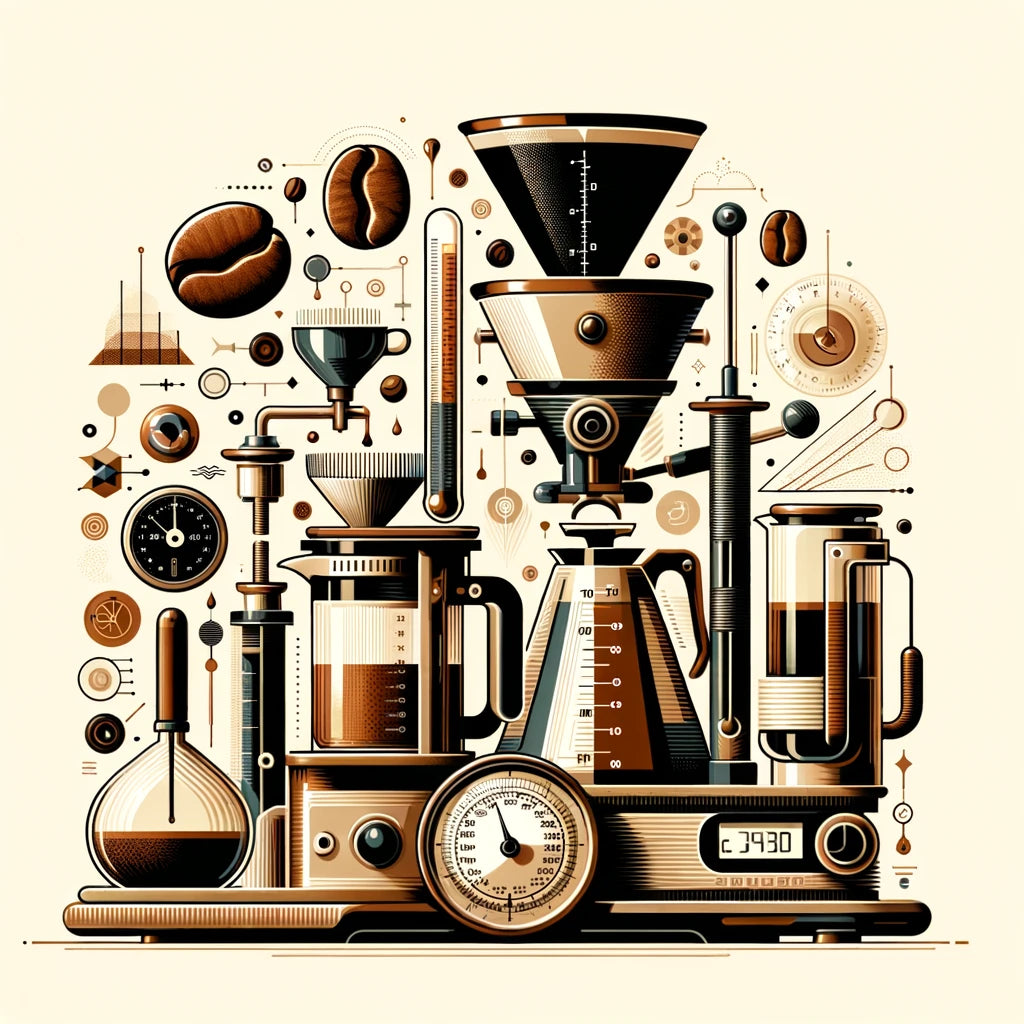General Brewing Guidelines
The content below is an abbreviated version of what you can find in our Experimental Design post. You will likely find the links below in this article helpful in dialing in your perfect brew at home, but please see our recommended Drip and AeroPress methods for more detail.
Grind Size
Generally speaking, finer grind sizes extract more quickly, resulting in a stronger and more intense flavor, while coarser grind sizes extract more slowly, producing a milder and less intense flavor. The optimal grind size varies based on the bean, with lighter roasts benefitting from finer grinds, and darker roasts benefitting from coarser grinds.
- Measurement: Measured in Microns. To get a customized grind size chart based on your coffee grinder, check out this awesome free resource - Honest Coffee Guide’s Coffee Grind Size Chart.
- Tools: Kruve Brewler
Water Temperature
Water temperature allows for proper extraction of the coffee's flavors and aromas (not to mention caffeine!), resulting in a more balanced and enjoyable cup of coffee. The optimal water temperature varies by brew method.
- Measurement: Measured in degrees Celsius
-
Tools: Liquid thermometer
Water Contact Time
Water contact time directly affects the extraction rate and overall flavor of the coffee, with shorter contact times resulting in milder flavors and longer contact times producing stronger and more intense flavors.
- Measurement: Timer with precise minutes and seconds.
- Tools: Timer
Water contact time is relevant for both Drip and AeroPress methods. To achieve the best results, we recommend following these guidelines:
- Drip: For drip brewers, water contact time is controlled by the brewer itself, which creates standardization. To achieve the best results, we recommend using an SCA-approved drip brewer and following the brewing instructions here.
-
AeroPress: AeroPress allows for a high level of customization with regards to water contact time, depending on which AeroPress recipe you use. To standardize water contact time across our AeroPress experiments, we used James Hoffmann’s Ultimate AeroPress Technique, further detailed here. Per Hoffmann’s experiments and our own, caffeine extraction plateaus after approximately two minutes of contact time. Our recommended time is 2:30. If you decide to brew for longer than this, it's unlikely to significantly increase caffeine extraction. However, we cannot guarantee the exact outcome, and we recommend sticking to our recommended method for precise and consistent results.
Ratios
Ratios (coffee to water) directly affect the caffeine content, extraction, and flavor profile of the coffee, as well as the overall extraction and balance of flavors. Achieving the right ratio ensures a well-balanced and enjoyable cup of coffee with precise and consistent caffeine content.
- Measurement: The ratio is measured as the weight of coffee in grams to the volume of water in milliliters. For accuracy, we used a digital kitchen scale to measure coffee and a liquid measuring cup to measure water. You may also choose to measure your water in grams as this is a 1:1 conversion (science fact - the original definition of a “gram” is one cubic centimeter of water which is equal to one milliliter!).
- Tools: Digital kitchen scale, liquid measuring cup
Ratios are relevant for both of our chosen brewing methods. To achieve the best results, we recommend following these guidelines for each of Our Beans and referencing our posts on Drip and AeroPress brewing methods.
Roast Level
Roast level impacts the coffee’s flavor, aroma, and caffeine content. It’s classically said that lighter roasts tend to have higher caffeine content and brighter, more acidic flavors, while darker roasts have lower caffeine content and richer, bolder flavors. However what you will notice when you look at our the data on each of Our Beans, is that the resulting coffee brewed may not necessarily follow this rule of thumb. The roast level also dictates grind size and extraction time and thus the resultant caffeine content. Read more about Caffeine Content here.
- Measurement: Roast level is typically determined by the color of the coffee beans during and after the roasting process. We visually assess the roast level and categorized them into light, medium, and dark roasts based on industry standards. Some of Our Beans are right on the border between one light/medium or medium/dark and that information is included on each product page to better represent the flavors you can expect from each single origin bean.
-
Tools: Visual inspection
Water Type
Water is crucial because it makes up more than 90% of your cup of coffee and serves as the solvent that extracts flavors, oils, and soluble compounds from the coffee grounds. The composition of water can significantly impact the quality of your cup, affecting the extraction process and taste.
- Use filtered water! For the best results, we recommend using filtered water. Hard water from the tap contains high levels of minerals like calcium and magnesium, which can result in over-extraction, leading to a bitter taste. Avoid using tap water with excessive mineral content or distilled water, as both can lead to undesirable flavors in your cup of coffee.


